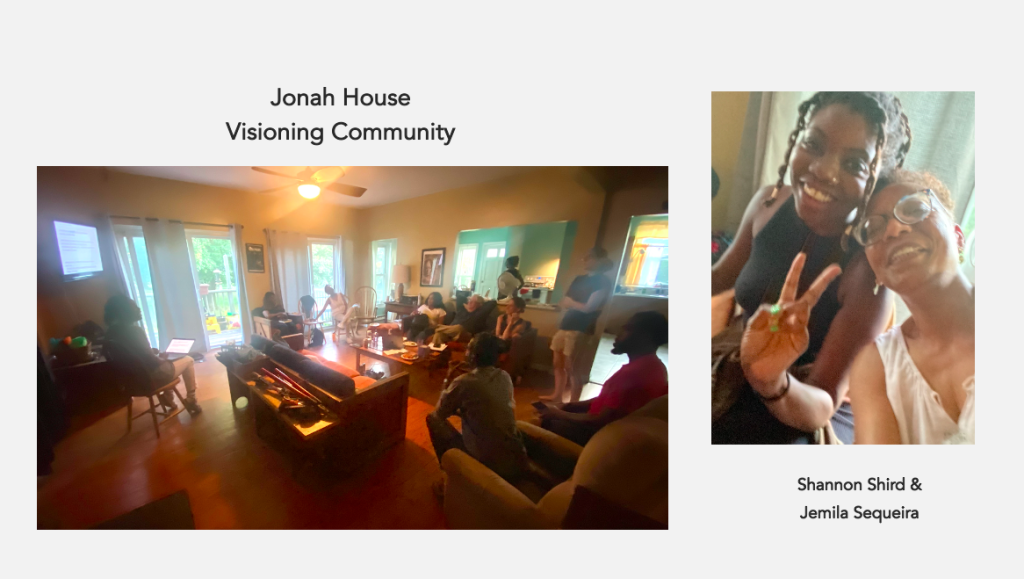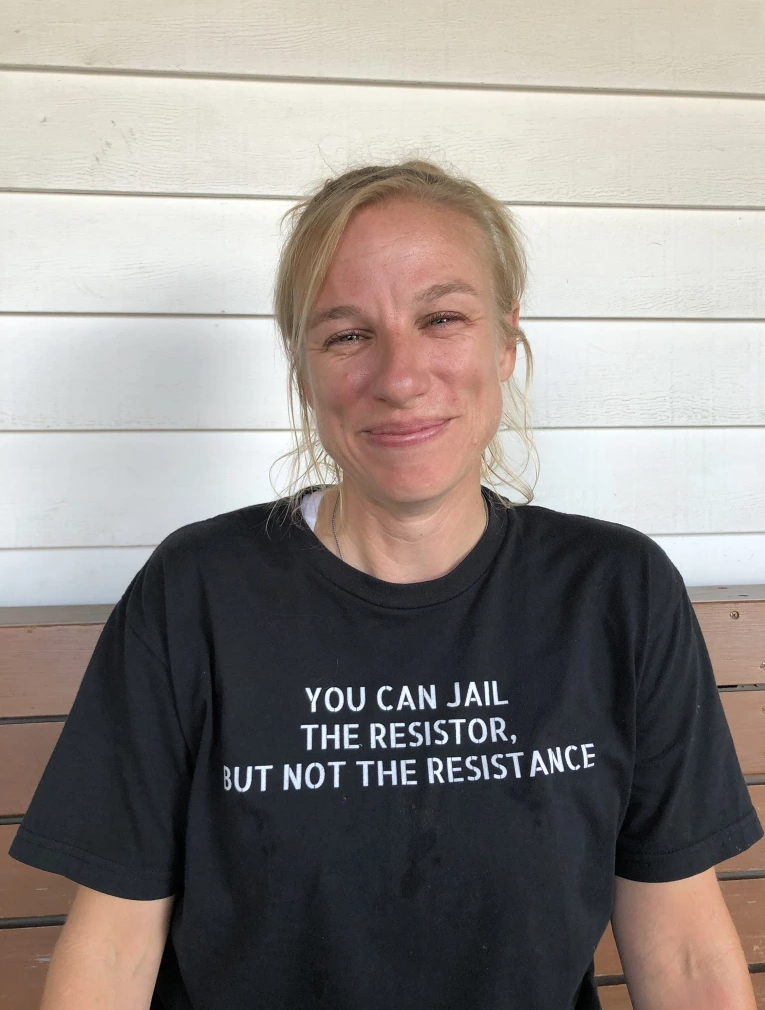Join us at the Impact Hub for the film screening and panel discussion of The Berrigans: Devout and Dangerous. Enjoy a meal together, celebrate our history, and learn about new happenings at Jonah House. RSVP here.


Join us at the Impact Hub for the film screening and panel discussion of The Berrigans: Devout and Dangerous. Enjoy a meal together, celebrate our history, and learn about new happenings at Jonah House. RSVP here.

We gathered again as Jonah House residents and Friends of Jonah House, and this time we named our Jonah House mission and vision. We look forward to building community with you inline with these values. Hope you’ll join us in Fall 2023 for the Jonah House 50th Anniversary Celebration.

We gathered at Jonah House as creatives, activists, and peace-makers to share community, honor our roots, and brainstorm a mission and vision.

We also shared a wonderful meal made by Jemila with ingredients from the community garden. Stay connected in the coming weeks for updates regarding our mission and for information about a celebration at Jonah House. We hope you’ll join us!
If you’d like to support the work and community of Jonah House, please make a donation or share ideas with us.
On June 10, 2023, many from the Jonah House community, past and present, gathered by webinar to commemorate our 50th Anniversary. The webinar titled, Jonah House: Fifty Years of Experiment in the Beatitudes, included the following speakers from our wonderful community of peacemakers: Willa Bickham, Brendan Walsh, John Bach, John Schuchardt, Mike Middleton, Barb Kass, Ellen Grady, Greg Boertje-Obed, Michele Naar-Obed, Carol Gilbert, Susan Crane, Gary Ashbeck, Katie Lautar, Jemila Sequiera, Frida Berrigan, & Jerry Berrigan.
Fr. Terry Moran put together the below presentation showcasing Johah House’s history, with beautiful photos from Frida Berrigan, Jerry Berrigan, Ellen Grady, and others. In Terry’s words, “May your lives be rich with the spirit of Jonah House!”

By Joe Byrne
As some of you know by now, I’ve left Jonah House. At the beginning of April, I moved down to Pinehurst, North Carolina, to live with, and take care of, my 90-year-old mother. My mom is at the point where she needs to either move into assisted living, or live with one of her kids. She’s chosen the latter course. And my siblings and I, as well as my mom and I, decided that I was the one most available to make the move, having no family of my own. That said, I did have a community I was leaving behind in Baltimore, and many friends, so my leaving was a challenge in that regard.
I moved to Jonah House in October 2015. I joined the community anchored by the Parr-Brown family–Tucker and Emily and little Auggie, then a year-and-a-half old. Within a year, we welcomed a new member into the community, little Evie, Tucker and Emily’s second child. Also part of Jonah House at that time were the “emeritus” members living separately in the cottage: Liz McAlister, Sr. Ardeth Platte, and Sr. Carol Gilbert.
The Parr-Brown family decided to move back west after two years; Liz, Ardeth, and Carol had left Jonah House the year before. I remained behind to form a new community. Joining me in 2017 were Paul Magno, Ausar Amen, Bow Williams, and Jemilla Sequiera.
The past six-and-a-half years at Jonah House have been a very rich time for me. I was able to be part of a tradition that I had admired for almost thirty years before I finally moved to Jonah House. It was also a challenging time in that the community was going through some changes, with long-time community members (including a founder) leaving Jonah House, and remaining members trying to envision a new direction and carrying on.
In my time at Jonah House, I was able to develop strong bonds with other community members, with the folks in the neighborhood who came on Tuesdays for food assistance, with those who attended Jonah House liturgy, and with the land itself. Over the six years I got to know the twenty-two acres of St. Peter’s Cemetery, where Jonah House resides, pretty well. I got to know the trees and flowers (and many, but not all, of their names), and the animals–the flora and fauna. I personally met raccoons, foxes, and deer; as well as barn owls, red-shouldered hawks, and guinea fowl (now no more due to the foxes!). The deer population in the cemetery grew from zero to eight in the time I was at Jonah House. Too many, actually. When I saw the deer (pretty much every day) I would say “Hello deer–and I don’t mean that affectionately.” That’s because they ate or otherwise damaged so many of the things I planted!
I also need to announce that my canine companion, Pema, has also left Jonah House. She is with me in North Carolina. It’s going to take some time for Pema to get used to her new living arrangement. In St. Peter’s Cemetery, I let her roam. And since the main gate was open most of the time, this means I also let her roam the neighborhood surrounding the cemetery. I hope the neighbors were fond of Pema; then again, maybe those who halted behind her and honked their horns when Pema paraded down the middle of Bentalou Street are happy she’s moved on. But at least no one ran her over or called Animal Control.
I will miss Jonah House, where I worked, prayed, and played for six plus years. But Jonah House continues, both as intentional community, and as extended community. There will still be a Jonah House when the community celebrates its 50th anniversary in 2023. I hope to return then, and will probably return before then, at least once.
For what it’s worth, all those I leave behind have my blessing, as do those who will come after me. I conclude with the phrase used by the early Franciscan friars as a greeting (and likely as a farewell): “Pax et bonum!” That is, “peace and good to you!”
By Joe Byrne
Today, with the help of a volunteer (Adam) I was able to get to a little project I’d been meaning to do for a while now. We transplanted some trees along the north fence of the cemetery, in the north-west quadrant.
On the other side of the north fence is an industrial site, including a lot of rusting equipment and shipping containers, as well as a mountain of shredded rubber tires. I thought it would be great to put up some trees to screen the cemetery from the industrial site. My idea was to use two different kind of trees: a top-canopy tree and a mid-level canopy tree. The two trees together, in two parallel rows, would provide a better screen than just the tall trees. The trees would have to be native and it would be great if they were already present in the cemetery. It would also be good if they could withstand the polluted run-off from the industrial site. Even better would be trees that would be unattractive to deer, so the deer wouldn’t crop the trees, or damage the tender trunks by rubbing off the bark with their horns (it’s the bucks that do that, not the does). A few years ago we planted some white pines along the north fence. A few still remain but quite a few of them died due to run-off pollution and damage from deer.
In the cemetery, we found some seedlings that I think fit the criteria listed above. For the top canopy tree, in a row of four closest to the fence, we transplanted some sycamore seedlings. There is already a very large sycamore tree along the north fence and it seems to be doing well. However we figured the very young sycamore trees would initially be susceptible to deer damage, so we put fences around them.
I’ve been experimenting with tree fencing for a while now. Putting up wooden posts and putting metal fencing around them does a pretty good job at protecting the trees, but that’s a lot of work, and it’s unsightly. The alternative I’ve come up with is to use leftover green plastic fencing (a kind of chicken mesh), and s’more sticks (doll rods) that we found at the Maryland Food Bank once upon a time. You cut of a length of fencing, use cheap wire ties to make it a closed circle. Then weave a s’more stick into the fencing and push it into the ground. Do three more in a circle (really, a diamond). After that, secure the bottom of the fencing with metal tent stakes. I found that, with just the s’more sticks, the fencing will topple over in a strong wind. With stakes, they stay upright and secure. The fencing looks kind of flimsy, but it looks solid enough to fool the deer. They could knock it down if they wanted to, but they don’t seem to want to. Even better, from a distance you can hardly see the green fencing.
After we had all the sycamore seedlings in, and fenced off, we planted four red bud trees in a row in front of the sycamores. Red buds are typically about half as high as mature sycamores. We already have some mature red buds in the cemetery, and they produce a lot of seedlings. I’ve transplanted some red bud seedlings before and noticed that the deer don’t mess with them. It might be that when they get bigger, the deer (the bucks) will go after them; so fencing might be necessary later. But for this planting, we left them without fencing.
One project done, but there are still plenty of places to plant more trees in the cemetery. Next time we plant trees, we’ll put the word out so that some those reading this might help out.
By Joe Byrne
Thich Nhat Hanh, the famed Vietnamese Zen Buddhist Monk and peacemaker, passed to the ultimate dimension on January 22, 2022. He was 95 years old.
Thay – his honorary title – became well known in the 1960s for his opposition to the Vietnam War. During that time, he urged his fellow monks and Buddhist practitioners in Vietnam to do war relief. This was the basis of what he would later call “engaged buddhism.” In 1966 he came to the United States to lobby the U.S. government for peace. Because of his refusal to take sides in the conflict, both the South Vietnamese government, and later the communist regime, refused to let Thich Nhat Hanh return to Vietnam. However, at the end of his life, after a debilitating stroke, the Vietnamese government allowed him to return to the monastery in Hue where he took his vows. And that is where he died, on January 22.
In the 1970s, Thay began to teach mindfulness to Vietnamese and Western practitioners. Initially, this movement attracted mostly anti-war activists, and indeed Thay emphasized that mindfulness was a practice for people to find inner peace to sustain them in the work for social justice. The mindfulness movement has long since gone mainstream.
In the 1960s, Thay was a friend to many peacemakers, most particularly Martin Luther King, Jr.; Daniel Berrigan, S.J.; and Thomas Merton. Martin Luther King nominated Thay for the Nobel Peace Prize. Merton wrote a famous essay entitled “Nhat Hanh is My Brother.” Berrigan co-wrote a book with Thay called The Raft is Not the Shore.
Echoing his teacher Gautama Buddha, Thay always said that he would live on his teachings, and in his students. He also lives on on the internet, in the form of dharma talks in written, audio and video formats; and in the teachings of his students, monastic and lay. There are all manner of such materials on the website of Plum Village, a monastic center he founded in France, and where he lived for many years.
I conclude with a poem written by Thich Nhat Hanh which is often recited at memorial services.
Contemplation of No-Coming, No-Going
This body is not me,
I am not limited by this body.
I am life without boundaries.
I have never been born, and I have never died.
Look at the ocean and the sky filled with stars,
Manifestations from my wondrous true mind.
Since before time, I have been free.
Birth and death are only doors through which we pass,
sacred thresholds on our journey.
Birth and death are a game of hide-and-seek.
So laugh with me,
hold my hand,
let us say good-bye,
say good-bye, to meet again soon.
We meet today,
We will meet again tomorrow.
We will meet at the source every moment.
We meet each other in all forms of life.
In 2016, Jessica Reznicek of the Des Moines Catholic Worker, after years of participating in various water protection actions led by Native American activists, and after exhausting all legal remedies, took direct action to stop the construction of Dakota Access Pipeline. She dismantled construction equipment and pipeline valves, taking particular care not to injure anyone. She pled guilty to one count of conspiracy to damage the pipeline. In 2021 she was sentenced to 8 years in prison.

Jessica should have been sentenced to only 37 months but, at the behest of federal prosecutors, Judge Rebecca Goodgame applied a domestic terrorism enhancement to Jessica’s case, to supposedly deter others from following Jessica’s lead. The terrorism enhancement nearly tripled Jessica’s sentence to 96 months.
This is nothing less than the criminalization of environmental protection and presents frightening consequences for anyone seeking to protect the environment from corporate destruction. The Dakota Access Pipeline is just one of many such oil and gas pipeline projects that have been fiercely resisted, particularly by those whose lands are being traversed by oil pipelines. These pipelines have a horrendous record of accidents and present a clear and present danger to all, in the form of carbon dioxide pollution, leading to global warming.
As NASA Climate Scientist Peter Kalmus put it, “Jessica was sentenced to 8 years for protecting all of us from climate and ecological breakdown. She acted from necessity and from love. She is a hero, not a terrorist.” She bravely acted to protect all of us, in this and future generations, and countless other beings.
The real terrorists are those who threaten the very life of the planet by digging up, and transporting, petrochemicals that need to remain in the ground if we are to have any hope of surviving climate change.
Follow the links below to read more about Jessica’s case, contact her in prison, and most importantly to sign the petition to have Jessica’s domestic terrorism enhancement removed.
Free Jessica Reznicek Face Book page: https://www.facebook.com/freejessrez
Free Jessica Reznicek Web Page https://supportjessicareznicek.com/
Jess Reznicek postings (Frank Cordaro’s website) https://frankcordaro.wordpress.com/2021/07/02/2021-jess-reznicek-postings/
Write:
Jessica Reznicek # 19293-030
FCI Waseca
PO Box 1731
Waseca, MN 56093